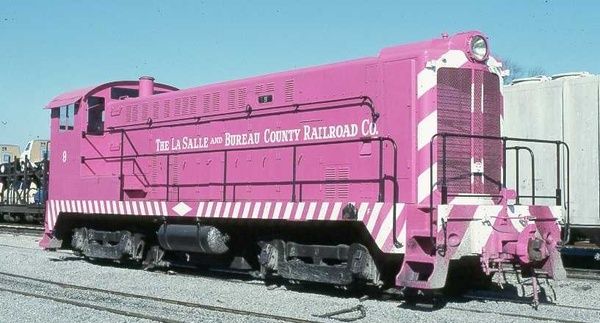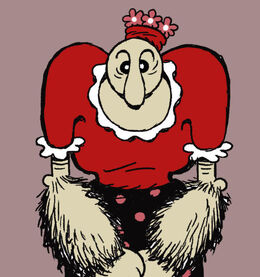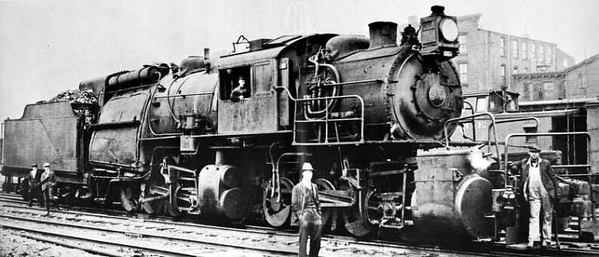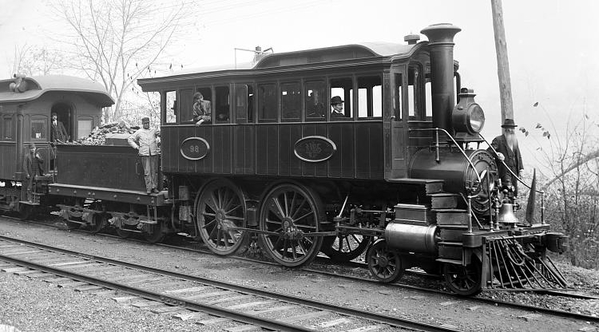Vincent Massi posted:
Those 1:32 Occre locomotive kits are pretty: here's the Russian C68.

|




|
The Russians actually did some real innovating. The first locomotive test facility was built in Russia in the 1880s almost 25 years before the vaunted Pennsy built theirs.
And of course, the Russians invented the 4-4-0.
Kent Loudon posted:And of course, the Russians invented the 4-4-0.
Don't you mean "inwented"?
![]()
palallin posted:Kent Loudon posted:And of course, the Russians invented the 4-4-0.
Don't you mean "inwented"?
Da, Comrade!
No! And I have someone who agrees with me! 22222222222222
22222222222222
Yes, if it comes with an all-girl crew!
Back on pages 3 and 4 of this thread some observations were made concerning the CB&Q's Aeolus. According to The Steamliners by Holland #4000 was unveiled at the CB&Q's West Burlington, Iowa shops on 11 April 1937. The name "Aeolus" is Greek for "the Keeper of the Winds". It was the winning entry in a name-that-locomotive contest sponsored by the Burlington Junior Chamber of Commerce. Mrs. Goldie Murray was the winner.
The American Flyer toy train #9915 is often said to be a model of the Aeolus but that isn't the case. Flyer first offered #9915 for sale in 1935 two years before the CB&Q engine and their engine was only cataloged for that single year. The 1935 catalog text concerning #9915 states "With railroad men, this basic design is gaining a tremendous following. In addition to the New York Central, the Milwaukee R.R. and the Baltimore & Ohio have produced locomotives of this character." In short, #9915 was a generic shrouded locomotive which tried to appeal to fans of a number of U.S. railroads. They failed.
Catalog Cut from 1935
#9915
Adriatic posted:Not a fan of the style, but of what's below the running boards. 😎 The look "Down Under" seems more appealing. I think the boiler lines accent better in lighter colors.
The Oz engines are narrow gauge and are of the 4-8-4 wheel arrangement so as to spread their weight across more axles to allow lower axle loadings. They are roughly in the performance class of a light pacific. The T1 look was no accident. They were deliberately styled to look like the Pennsy engines. Another class of Australian 4-8-4s wore a Daylight inspired paint scheme and skirts and were used to pull a named train called "The Overland". They were built as 4-8-2s but became 4-8-4s when a 4-wheel booster truck replaced the 2-wheel trailer.

Robert S. Butler posted:Back on pages 3 and 4 of this thread some observations were made concerning the CB&Q's Aeolus. According to The Steamliners by Holland #4000 was unveiled at the CB&Q's West Burlington, Iowa shops on 11 April 1937. The name "Aeolus" is Greek for "the Keeper of the Winds". It was the winning entry in a name-that-locomotive contest sponsored by the Burlington Junior Chamber of Commerce. Mrs. Goldie Murray was the winner.
The American Flyer toy train #9915 is often said to be a model of the Aeolus but that isn't the case. Flyer first offered #9915 for sale in 1935 two years before the CB&Q engine and their engine was only cataloged for that single year. The 1935 catalog text concerning #9915 states "With railroad men, this basic design is gaining a tremendous following. In addition to the New York Central, the Milwaukee R.R. and the Baltimore & Ohio have produced locomotives of this character." In short, #9915 was a generic shrouded locomotive which tried to appeal to fans of a number of U.S. railroads. They failed.
Catalog Cut from 1935
#9915
Poor "Aeolus" suffered the ignominious honor of being nicknamed "Big Alice the Goon" after a character in the "Popeye" comic strip.
Railroaders are a cruel lot.
The original "Alice the Goon".

Note double catenary. What's the voltage ?
Hmm.. a post didn't take... I have part on my clip board maybe..yep..
I had heard "Alice", but didn't realize it was it was the ÆOLUS; nor the Oz-T1 was narrow gauge.
Not getting to see Australia/New Zealand with my own eyes is at the rim of my Bucket of Regrets. The road semi-truck road trains are something I wanted to check out too.
I used to love Alice & Jeep, but really just waited around for party-animal Poopdeck Pappy's crusty demeanor to steal the show.
Kent Loudon posted:And of course, the Russians invented the 4-4-0.
Where did you come up with that little bit of misinformation?
Friendly discussion, as well as courteous disagreement, is always welcome on my threads. According to Wikipedia "...the first 4-4-0 locomotive was designed by Henry R. Campbell, at the time the chief engineer for the Philadelphia, Germantown and Norristown Railway. Campbell received a patent for the design in February 1836 and soon set to work building the first 4-4-0.[1] "
It SEEMS that the British then invented a 4-4-0 a few years later.
Vincent Massi posted:Friendly discussion, as well as courteous disagreement, is always welcome on my threads. According to Wikipedia "...the first 4-4-0 locomotive was designed by Henry R. Campbell, at the time the chief engineer for the Philadelphia, Germantown and Norristown Railway. Campbell received a patent for the design in February 1836 and soon set to work building the first 4-4-0.[1] "
It SEEMS that the British then invented a 4-4-0 a few years later.
Vincent Massi posted:The terms "Camel," "Camelback," and "Mother Hubbard" are sometimes used interchangeably. They all refer to a locomotive with the cab in the middle, over the boiler. The idea behind this dangerous design was to put more weight in the driving wheels and give the engineer a better view.
The idea was to provide an extremely wide firebox, which would have blocked any forward view.
smd4 posted:Kent Loudon posted:And of course, the Russians invented the 4-4-0.
Where did you come up with that little bit of misinformation?
It's a joke, son; it's a joke (the Russians inwented everything first--just listen to Russian history as related by Pavel Chekhov).
Vincent Massi posted:The terms "Camel," "Camelback," and "Mother Hubbard" are sometimes used interchangeably.
This isn't accurate. The term "Camel" refers to a specific type of locomotive--the Winans Camel.
From Wikipedia:
"The camel and the camelback design were developed separately by two different railroads in different eras. Though the name is often incorrectly used interchangeably, they had little in common other than the placement of the cab. Unlike the later Camelbacks, Camels had cabs that rode atop the boiler. Ross Winans wanted to put as much weight on the driving wheels as possible to increase traction. Camelbacks have a cab that straddles the boiler. While Camelbacks have the same idea of moving the cab forward, they had it for different reasons. Camelbacks were developed to allow for the use of larger fireboxes, such as the Wootten, which would obstruct the engineer's view from a conventionally placed cab."
Right you are, Steve. It is inaccurate to use the terms "Camel," Camelback," and "Mother Hubbard" interchangeably.
Vincent Massi posted:Right you are, Steve. It is inaccurate to use the terms "Camel," Camelback," and "Mother Hubbard" interchangeably.
"Camelback" and "Mother Hubbard" used interchangeably are fine; "Camel" is a different beast entirely.
Vincent Massi posted:
This one is actually an older K-Line car out of the box (my picture). K-Line had 2 Hanukkah Box Cars, Lionel has one that came out last year, and Lionel has a Mogen David Jewish Wine Vat Car. ![]()
The phrase "Mother Hubbard" was usually used for locos whose cab sat completely on top of the boiler but did not straddle the boiler's sides. The first photo was the largest loco in the world at the time. It was primarily designed as a "pusher" in steep mountain areas and could not surpass 30 mph. The second is a track inspector.


Regards
Fred
Vincent Massi posted:
They must have been experimenting with props; I wonder which one was better for the train. Those photos make me wonder if they ever tried a three-bladed prop. And not to mention that spinning prop unprotected and so close to the platform! Still, I would not mind a reasonably priced true O scale model of it.
PRRMP54 posted:Vincent Massi posted:They must have been experimenting with props; I wonder which one was better for the train. Those photos make me wonder if they ever tried a three-bladed prop. And not to mention that spinning prop unprotected and so close to the platform! Still, I would not mind a reasonably priced true O scale model of it.
The Rail Zeppelin was a 1929 version of the 1966 New York Central Jet Powered RDC-3 M-497. A way a testing the tracks for high speed trains.
Stuart
Access to this requires an OGR Forum Supporting Membership
